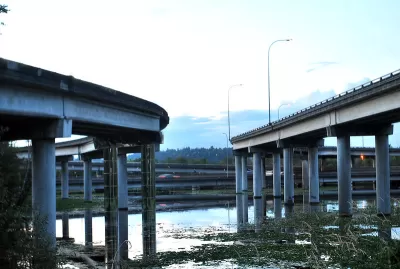The history of Seattle's opposition to car infrastructure is being commemorated while it's being made.

Knute Berger and Stephen Hegg write to update the history of Seattle's "ramps to nowhere"—the vestiges of the city's mid-20th century freeway building binge that came to a halt in a wave of environmental activism in 1972.
The most famous example of ramps to nowhere, and the subject of this exploration, are the remnants of the R.H. Thomson Expressway.
R.H. Thomson Expressway on and offramps had been built when the Evergreen Point Bridge — the State Route 520 floating bridge — was built in the early 1960s. They just sat waiting for the expressway to be attached. But they stood unconnected, like ancient ruins or garden follies. Instead of carrying cars, kids would jump off them into Lake Washington during warm summer days. They were used by swimmers and sunbathers. They were very expensive diving boards.
As noted by Berger and Hegg, the R.H. Thompson Expressway ramps to nowhere have taken on a symbolism attached to the civic activism that halted construction of the project. In the past, residents have advocated for the preservation of the ramps to commemorate those efforts. According to the article, one ramp will remain standing for that purpose, but the rest are coming down.
In a bit of synchronicity between past and present, the city of Seattle is currently debating the need to expand some of its existing bridges for cars, as highlighted in a separate article by the editorial board of The Urbanist. The Magnolia Bridge, "[s]erving a peninsula with some 20,000 residents and two other bridges over the Interbay railyard," is the perfect example of the tendency for elected officials in Seattle to push for car infrastructure as a matter of regional and even national priority (in that way, Seattle-area politicians certainly resemble politicians in other corners of the country). Clearly, the editorial board of The Urbanist aims to follow in the footsteps of their anti-highway forebears.
FULL STORY: An end to Seattle’s ramps to nowhere

Alabama: Trump Terminates Settlements for Black Communities Harmed By Raw Sewage
Trump deemed the landmark civil rights agreement “illegal DEI and environmental justice policy.”

Study: Maui’s Plan to Convert Vacation Rentals to Long-Term Housing Could Cause Nearly $1 Billion Economic Loss
The plan would reduce visitor accommodation by 25% resulting in 1,900 jobs lost.

Planetizen Federal Action Tracker
A weekly monitor of how Trump’s orders and actions are impacting planners and planning in America.

Wind Energy on the Rise Despite Federal Policy Reversal
The Trump administration is revoking federal support for renewable energy, but demand for new projects continues unabated.

Passengers Flock to Caltrain After Electrification
The new electric trains are running faster and more reliably, leading to strong ridership growth on the Bay Area rail system.

Texas Churches Rally Behind ‘Yes in God’s Back Yard’ Legislation
Religious leaders want the state to reduce zoning regulations to streamline leasing church-owned land to housing developers.
Urban Design for Planners 1: Software Tools
This six-course series explores essential urban design concepts using open source software and equips planners with the tools they need to participate fully in the urban design process.
Planning for Universal Design
Learn the tools for implementing Universal Design in planning regulations.
Caltrans
Smith Gee Studio
Institute for Housing and Urban Development Studies (IHS)
City of Grandview
Harvard GSD Executive Education
Toledo-Lucas County Plan Commissions
Salt Lake City
NYU Wagner Graduate School of Public Service





























